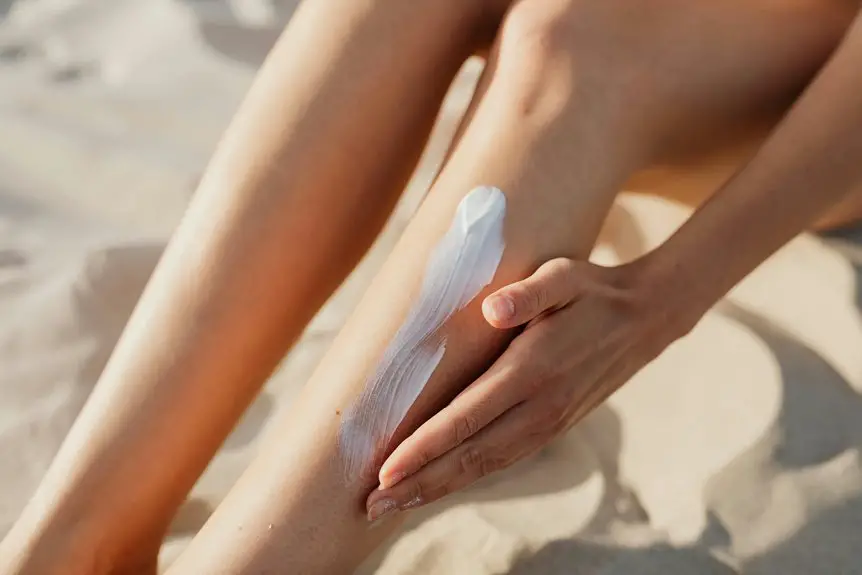When it comes to protecting yourself from harmful UV rays, you might wonder if natural fabrics can offer effective defense. You’ll find that some materials, like unbleached cotton and linen, boast impressive UV-blocking properties. However, not all natural fibers are created equal. Understanding how each fabric performs can help you make informed choices for your wardrobe and outdoor activities. So, what should you consider before making a selection?
Table of Contents
Key Takeaways
- Natural fibers like linen, hemp, and unbleached cotton effectively block UV rays due to their tight weave and structure.
- Merino wool provides moderate UV protection while maintaining breathability and moisture-wicking properties for comfort.
- Silk’s smooth surface and high luster can reflect sunlight, enhancing its UV protection when compared to duller fabrics.
- While rayon is less effective at blocking UV rays, unbleached cotton and linen are better alternatives for sun safety.
- Blending natural and synthetic fibers can optimize UV protection while maintaining comfort and breathability.
Overview of Natural Fibers and UV Protection
Natural fibers are a fantastic choice for those seeking effective UV protection in their clothing. They’re breathable, comfortable, and often have natural UV-blocking properties.
When you choose fabrics like linen, hemp, or wool, you’re not only opting for sustainability but also for a shield against harmful rays. These materials can absorb UV radiation, preventing it from reaching your skin.
Unlike synthetic alternatives, natural fibers allow for better air circulation, keeping you cool while offering protection. Plus, their durability guarantees your clothing lasts longer, maintaining its protective qualities over time.
Unbleached Cotton: A Natural Shield Against UV Rays
While many fabrics claim to offer UV protection, unbleached cotton stands out as a reliable choice for those who want both comfort and safety from harmful rays. Its natural properties provide an effective barrier while maintaining breathability.
Unbleached cotton combines comfort and UV protection, offering a breathable barrier against harmful rays.
Here’s why you should consider unbleached cotton:
- Natural Fiber: Unbleached cotton is free from harsh chemicals, making it safer for your skin.
- UV Resistance: The tightly woven fibers offer excellent UV-blocking capabilities.
- Comfortable Wear: It’s soft and gentle, perfect for long days outdoors.
- Eco-Friendly: Choosing unbleached cotton supports sustainability and reduces environmental impact.
Merino Wool: Moderate Protection From the Sun
Merino wool offers a unique blend of comfort and sun protection, making it a great option for outdoor enthusiasts. While it doesn’t provide complete UV blocking, it does offer moderate protection, allowing you to enjoy the sun without worry. Its natural fibers breathe well, keeping you cool during warm days.
Here’s a quick comparison of Merino wool’s sun protection features:
| Feature | Description |
|---|---|
| UV Protection Level | Moderate (UPF 15-25) |
| Breathability | Excellent |
| Moisture-Wicking | Yes |
| Softness | Luxuriously soft and comfortable |
When choosing your outdoor gear, consider Merino wool for a balance of comfort and sun defense. You’ll appreciate its versatility and performance on sunny adventures!
The Reflective Qualities of Silk
Silk, renowned for its luxurious feel, also boasts impressive reflective qualities that enhance its ability to protect against harmful UV rays. When you wear silk, you benefit from its natural ability to reflect sunlight, which can reduce your exposure to potentially damaging rays.
Here are some key reflective features of silk:
- Smooth Surface: The sleek texture of silk minimizes light absorption.
- High Luster: Its shiny finish reflects more sunlight compared to dull fabrics.
- Lightweight: The airy nature allows for breathability while still providing protection.
- Color Versatility: Darker silk shades can absorb UV rays, but lighter colors enhance reflectivity.
Flax and Hemp: Understanding Their UV Defense
When it comes to UV protection, flax and hemp stand out for their unique natural properties.
You’ll find that the way these fibers are constructed influences their ability to block harmful rays.
Let’s explore how these materials can keep you safe from the sun while still being eco-friendly.
Natural Fiber Properties
While many fabrics offer some level of UV protection, flax and hemp stand out due to their unique properties.
These natural fibers not only provide comfort but also enhance your defense against harmful UV rays. Here’s what makes them exceptional:
- Tight Weave: Their dense structure blocks more sunlight than loosely woven fabrics.
- Natural Resilience: Both fibers are durable, ensuring they maintain their protective qualities over time.
- Breathability: Flax and hemp allow air circulation, keeping you cool while protecting you from the sun.
- Moisture Management: They absorb moisture, reducing perspiration and making them ideal for hot weather wear.
Choosing flax or hemp fabrics means you’re not just stylish but also actively protecting your skin from UV damage.
UV Protection Levels
Understanding the UV protection levels of flax and hemp fabrics can help you make informed choices for sun safety.
Both materials offer varying degrees of UV defense. Hemp, for instance, is naturally resistant to UV rays due to its dense fibers, often providing a higher Ultraviolet Protection Factor (UPF) compared to flax.
Flax, while also effective, typically has a lower UPF rating, but its lightweight nature makes it breathable and comfortable for warmer weather.
When choosing between the two, consider your activity level and sun exposure. If you’ll be outdoors for extended periods, hemp might serve you better.
Ultimately, both fabrics can enhance your sun protection wardrobe, so weigh their UV defense alongside comfort and style preferences.
Fabric Construction Impact
The way flax and hemp fabrics are constructed greatly influences their ability to block UV rays.
You’ll find that specific factors play an essential role in their UV defense:
- Tight Weave: A tighter weave can reduce UV penetration.
- Fiber Thickness: Thicker fibers tend to provide better protection.
- Color: Darker shades absorb more UV rays than lighter ones.
- Finish: Treatments like dyes or coatings can enhance UV-blocking properties.
Limitations of Rayon in UV Protection
While rayon might feel comfortable, it falls short when it comes to UV protection.
Its low protection level and weak fiber structure make it less effective than other natural fabrics.
If you’re looking for better sun defense, you might want to explore alternatives like flax or hemp instead.
Low UV Protection Level
Although rayon offers a soft, comfortable feel, its ability to block UV rays falls short compared to other natural fabrics.
If you’re considering rayon for sun protection, keep in mind these limitations:
- Low UV Protection: Rayon typically has a UPF rating lower than cotton or linen.
- Thin Fabric: The lightweight nature of rayon means it’s less effective at blocking harmful rays.
- Moisture Absorption: While rayon absorbs moisture well, wet fabric can further reduce its UV-blocking capabilities.
- Color and Dye Impact: The dye used in rayon can affect its UV protection, often resulting in less effective shielding.
For better UV protection, you might want to explore other natural fabrics that provide enhanced defense against harmful sun exposure.
Fiber Structure Weakness
Rayon’s fiber structure plays a significant role in its limitations for UV protection. Unlike tightly woven fabrics, rayon fibers are relatively loose and can allow UV rays to penetrate more easily.
This openness means that while rayon feels soft and breathable, it doesn’t provide the dense barrier needed to block harmful rays effectively. Additionally, rayon’s smooth texture tends to reflect less light, which can contribute to its overall ineffectiveness in UV defense.
You might find that wearing rayon in bright sunlight exposes your skin more than you’d prefer.
Comparison With Alternatives
When you compare rayon to other natural fabrics like cotton or linen, its limitations in UV protection become more apparent.
Here’s why rayon mightn’t be your best choice for sun protection:
- Fiber Structure: Rayon fibers are less dense, allowing more UV rays to penetrate through.
- Moisture Absorption: Rayon absorbs moisture, which can lead to fabric stretching and decreased UV blocking.
- Durability: Rayon’s weaker structure makes it prone to wear and tear, reducing its lifespan and protective qualities.
- Color Fading: Rayon tends to fade quicker than cotton or linen, further diminishing its effectiveness in UV protection.
Considering these factors, you might want to explore cotton or linen for better sun safety.
Comparing Natural and Synthetic Fabrics for UV Safety
Many people often wonder how natural fabrics stack up against synthetic ones regarding UV protection.
While natural fabrics like cotton and linen offer breathability and comfort, they typically have lower UV protection unless treated.
On the other hand, synthetic fabrics, such as polyester and nylon, often have higher UV-blocking capabilities due to their tight weaves and special finishes.
However, they can trap heat, making them less comfortable in warmer climates.
You might find that blends of natural and synthetic fibers provide a good balance of breathability and UV safety.
Ultimately, when choosing your clothing, consider the fabric type, weave, and any UV protection treatments to guarantee you stay safe from harmful rays while enjoying the outdoors.
Frequently Asked Questions
How Do Natural Fabrics Compare to Synthetic Fabrics in UV Protection?
When comparing natural fabrics to synthetic ones, you’ll find that synthetic materials often provide better UV protection. However, some tightly woven natural fabrics can also offer decent defense against harmful rays, depending on their density and color.
Can I Enhance UV Protection in Natural Fabrics at Home?
Ever wondered how to boost your natural fabric’s UV protection at home? You can try applying fabric treatments, using darker colors, or layering fabrics to enhance their effectiveness against harmful rays while still enjoying the comfort of nature.
What Factors Affect the UV Protection Level of Natural Fabrics?
Several factors affect the UV protection level of natural fabrics. These include the fabric’s weave density, color, fiber type, and treatment. Darker, tightly woven fabrics generally offer better protection than lighter, loosely woven options.
Are There Specific Brands Known for Uv-Protective Natural Clothing?
You’ll find several brands that specialize in UV-protective natural clothing. Look into companies like Coolibar, Patagonia, and Columbia. They offer stylish options that combine comfort with effective sun protection, ensuring you stay safe outdoors.
How Often Should I Wash Uv-Protective Fabrics to Maintain Effectiveness?
How often do you think you should wash your UV-protective fabrics? Ideally, wash them every few wears or after heavy use. This helps maintain their protective qualities, ensuring you stay safe from harmful UV rays.
- Does Chiffon Fabric Stink - July 15, 2025
- Does Chiffon Fabric Affect the Economy - July 15, 2025
- Does Cotton Fabric Have a Nap - July 15, 2025







